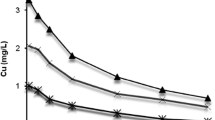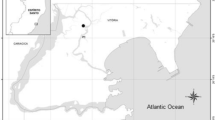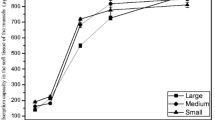Abstract
The kinetics of copper bioaccumulation in the rock oyster Crassostrea cucullata Born showed that the initial rate of uptake was directly related to metal concentration in the medium. As the accumulation in the tissues increased, the oysters remained closed and the uptake rate fell. At the end of 7 weeks, the average copper concentrations in the tissue were 60.42 μg g-1 and 63.97 μg g-1 wet weight in the 0.01 and 0.05 ppm experimental groups, respectively. The net rate of uptake ranged from 1.76 to 1.97 μg g-1 week-1 and the rate of copper loss, measured after transferring the oysters into natural sea water, was dependent on the original cooper concentration in the soft parts. The concentration of copper in the tissues declined by 37.38 and 36.56% in the 0.01 and 0.05 ppm experimental groups, respectively. Even after a 7 week period of depuration (self-purification) there was some residual copper left in the tissue. This indicates that accumulation occurs in the tissue more rapidly than cleansing can eliminate it.
Similar content being viewed by others
Literature Cited
Bernhard, M.: Manual of methods in aquatic environment research. Part 3. Sampling and analysis of biological material [Guidelines for the FAO (GFCM/UNEP) Joint coordinated project on Pollution in the Mediterranean]. F.A.O. Fish. tech. Pap. 158, 1–24 (1976)
Boyce, R. and W.A. Herdman: On a green leucocytosis in oysters associated with the presence of copper in the leucocytes. Proc. R. Soc. (Ser. B) 62, 30–38 (1897)
Brooks, R.R. and M.G. Rumsby: The biogeochemistry of trace elemental uptake by some New Zealand bivalves. Limnol. Oceanogr. 10, 521–528 (1965)
Bryan, G.W.: The effects of heavy metals (other than mercury) on marine and estuarine organisms. Proc. R. Soc. (Ser. B) 117, 389–410 (1971)
Cunningham, P.A. and M.R. Tripp: Accumulation and depuration of mercury in the American oyster Crassostrea virginica. Mar. Biol. 20, 14–19 (1973)
George, S.G., B.J.S. Pirie, A.R. Cheyne, T.L. Coombs and P.T. Grant: Detoxication of metals by marine bivalves: an ultrastructural study of the compartmentation of copper and zinc in the oyster Ostrea edulis. Mar. Biol. 45, 147–156 (1978)
Ikuta, K.: Studies on accumulation of heavy metals in aquatic organisms. I. On the copper content in oysters. Bull. Jap. Soc. Scient. Fish. 33, 405–409 (1967)
McKee, J.E. and H.W. Wolf: Water quality criteria. Publs Calif. St. Wat. Qual. Control Bd 3A, 1–548 (1963)
Pringle, B.H., D.E. Hissong, E. Katz and S.T. Mulawka: Trace metal accumulation by estuarine molluscs. J. sanit. Engng Div. Am. Soc. civ. Engrs 94 (5970), 455–475 (1968)
Schulz-Baldes, M.: Lead uptake from sea water and food, and lead loss in the common mussel Mytilus edulis. Mar. Biol. 25, 177–193 (1974)
Shuster, C. and B.H. Pringle: Trace metal accumulation by the American oyster, Crassostrea virginica. Proc. natn. Shellfish. Ass. 59, 93–103 (1969)
Author information
Authors and Affiliations
Additional information
Communicated by O. Kinne, Hamburg
Rights and permissions
About this article
Cite this article
Silva, C.D., Qasim, S.Z. Bioaccumulation and elimination of copper in the rock oyster Crassostrea cucullata . Marine Biology 52, 343–346 (1979). https://doi.org/10.1007/BF00389075
Accepted:
Issue Date:
DOI: https://doi.org/10.1007/BF00389075




